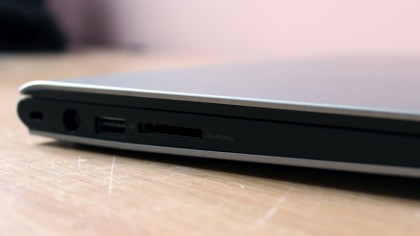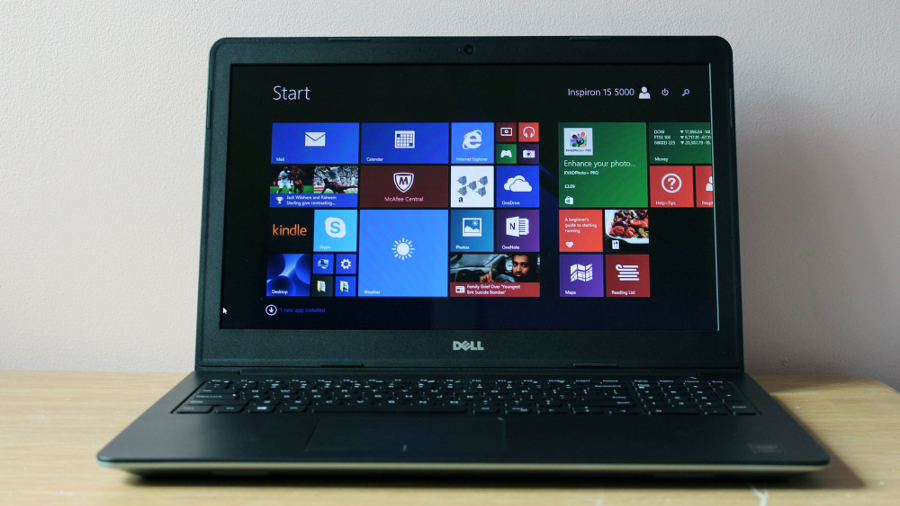Why you can trust TechRadar
We put this Dell offering through its paces, and here are the resulting benchmark scores:
- PCMark 8 Home: 3658
- PCMark 8 Home battery life balanced 50% screen: 3hr 21m
- PCMark 8 Home battery life power saver 25% screen: 4hr 2m
- PCMark 8 Home high performance 100% screen battery life: 3hr 1m
- 3DMark: Cloud Gate: 5558; Sky Diver: 4249; Fire Strike: 1211
- Cinebench R15: CPU: 245cb; Graphics: 36.83fps
One of the Dell's most impressive components is the Core i7-5500U, which is a new chip from Intel's latest range of processors: Broadwell. This new architecture serves up performance improvements, but it also places huge emphasis on better efficiency and battery life.

It's the same chip as the Asus Transformer laptop, and it's a couple of steps ahead of the Lenovo, which had a weaker Broadwell part that's a couple of hundred Megahertz slower.
The Dell performed well in our processor benchmarks. Its PCMark 8 Home result of 3,658 beat both rivals – the Lenovo ThinkPad X250 scored 2,238 points and the Asus Transformer Book Flip TP300LA managed 2,521. In Cinebench's CPU test the Dell topped out at 245 points – only three points behind the Lenovo but unable to match the Asus machine's 300 point score.
The Inspiron has an AMD Radeon R7 M265 graphics core, which gives it a leg-up on rivals that rely on Intel's integrated graphics. It's a mid-range chip with 384 stream processors, and it returned a score of 1,211 in 3DMark's tough Fire Strike test – hundreds of points better than either competitor.
It's able to outpace both rivals in games, but the Dell fell behind the competition in battery life tests. With its screen at 50% brightness and PCMark 8's Home test running it lasted for 3 hours and 21 minutes before running out of juice – twelve minutes fewer than the Lenovo, but more than an hour behind the Asus. The situation didn't improve much when we dimmed the screen to 25% brightness, with that result only increasing by less than an hour.

You'll certainly notice this machine when its components are pushed; with its processor and graphics chip running demanding benchmarks the internal fans churned out a reasonable amount of noise. If that noise is going to prove irritating then headphones are a good idea – especially because the fans in our review machine churned inconsistently even after we'd stopped benchmarking.
Sign up to the TechRadar Pro newsletter to get all the top news, opinion, features and guidance your business needs to succeed!
Despite that qualm there's no denying the well-balanced nature of the Inspiron's specification. The Core i7 processor has the grunt for demanding work software, and the Radeon graphics core is capable of playing games at middling quality settings.
Screen and speakers
The screen, though, is a disappointment. Its 1,366 x 768 resolution matches the Asus but falls behind the Lenovo's full HD panel, and it proves restrictive: it's not possible to watch 1080p movies on this panel, and working with multiple windows is difficult.
The display probably won’t win any awards, either. It’s 189cd/m2 brightness level is great for the office, but won’t do so well outside. And, it’s black level of 0.73cd/m2 is just disappointing – it means black tones just aren’t deep enough. The resulting contrast ratio of 250:1 fails to impress and fails to produce enough tone variation to make pictures, films and games look their best – bright white shades and dark blacks that should show slight differences just blend together.

Colours suffer from poor accuracy levels, with a colour temperature of 7,761K that's just far too cool.
The result is a screen without the quality or resolution for serious work, with a lack of contrast and colour accuracy being its main problems. It's fine for web browsing and casual media consumption, but that's about it.
It's a similar story with the audio kit. It's got enough volume and good mid-range sounds to ensure vocals sound great, but its top-end is tinny and the bass just isn't strong enough, which means music, movies and games all lack punch.
Mike has worked as a technology journalist for more than a decade and has written for most of the UK’s big technology titles alongside numerous global outlets. He loves PCs, laptops and any new hardware, and covers everything from the latest business trends to high-end gaming gear.
